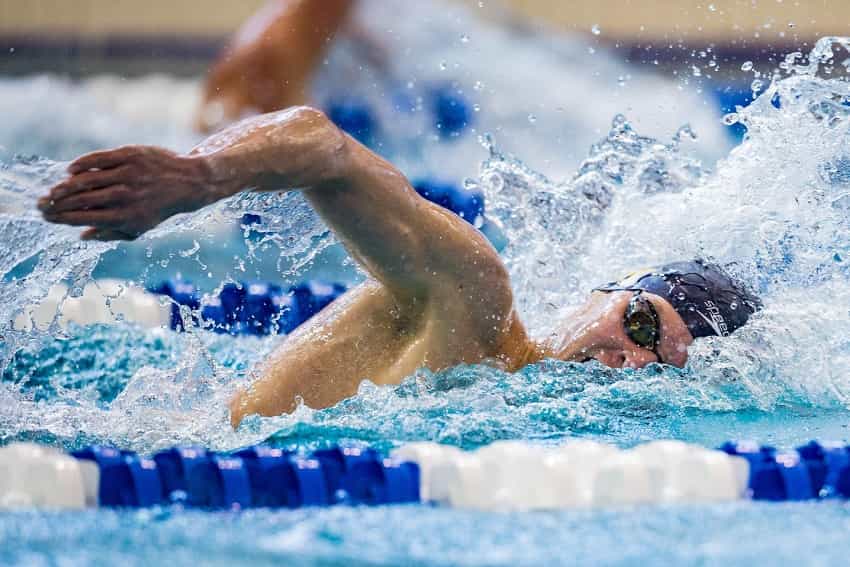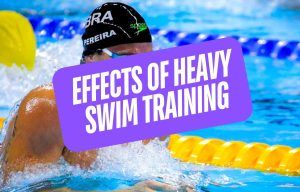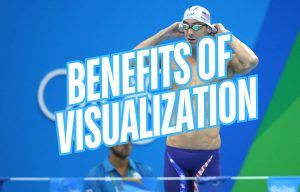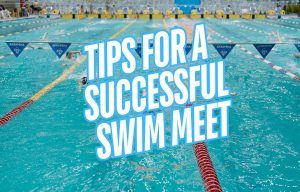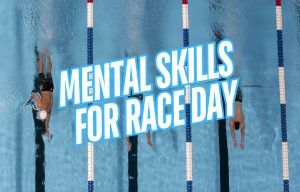When it comes to mental skills for swimmers, visualization or mental imagery is one of the sneaky weapons swimmers have for improving every aspect of their performance in the water.
- Missy Franklin relied on mentally rehearsing her performances ahead of time so that when it came to the big day, she could cut down on the overthinking and swim her because she’d “already pictured what’s going to happen a million times, so I don’t actually have to think about it.”
- Katie Ledecky pictured how she wanted to feel at each part of her race to keep herself locked in. “I know what my stroke should feel like at each part of the race, and I can just kind of picture that in my mind.”
- By visualizing ourselves doing the work we need to do—showing up to early morning practices, conquering hard sets, eating like a champ—we are more likely to do them and consequently perform at a higher level.
And so on.
The ways that visualization can be used are almost endless.
But the one biggie that swimmers should focus on is creating a stockpile of race-day simulations that match the emotion and pressure of competition.
This way, when you step up on the blocks, and the pressure is on, you have a strong, confidence-boosting sense of “been here, done this.”
So that when you lace up that fancy-pants tech suit, your training and preparation doesn’t crumble.
Mike Bottom on Using Visualization
Coaching legend Mike Bottom, who has sharpened some of the fastest swimmers on the planet from his time at Auburn, Cal, USC, The Race Club, University of Michigan, and as coach on the 2016 US Olympic coaching staff, uses visualization to help pressure-proof his swimmers.
While practice is designed to help prepare a swimmer for competition, there are parts of the competitive experience that are very hard to mimic in a training situation. For example, the stress and anxiety of swimming under pressure, under the lights, under the eyes of friends, family, teammates, and a whole bunch of strangers.
This pressure can take a well-trained swimmer and shatter their performance when the pressure hits.
Bottom, in talking at an ASCA conference, spoke about the role of mental training and visualization on getting his swimmers at Auburn to perform at a high level at NCAA’s. (Emphasis mine.)
Mental training was key to our success. We would do rehearsal, deep visualization, and talk. You can’t change subconscious patterns in athletes unless you try to hit the subconscious and there are several different ways of doing that. You hit the subconscious with repetition and visualization.
The thing that I found, especially with age groupers, is that you tell them what to do, how to change their stroke and they have it perfect in practice. They’re swimming and you’re going, “Yeah! He’s catching right!” Then they get to the meet and look at the block and you have a different swimmer. You have that old swimmer that takes off and does exactly the same thing wrong.
You try to think about what happened. You try to keep your cool. You try not to strangle them. You ask them, “What have I been telling you?”
The problem is that it didn’t reach the subconscious level in a race situation. It reaches the subconscious level in the practice situation, the nice low pace situation. In the race situation, when the pressure is on, and when there were people screaming and hollering, and the coach was looking right at you, it all went away. They went back to the subconscious tapes that played way back when. They reverted back.
Somehow you have to get to that subconscious, and you can do it in several ways. You could do it with race rehearsals, or you could do it with visualization. I think the best way to do it is to get them to know what it feels like and then use visualization to implant that into their subconscious.
Put visualization to work for you
I have written a lot about visualization on this website (and there is also extensive instructions and tips in my mental training workbook, Conquer the Pool).
Here are a few quick tips on how to make visualization work for you, as well as supplemental resources on mental rehearsals.
- Prepare for adversity. Nothing ever goes perfectly on race day. You stub a finger during warm-up. A competitor dusts everyone during prelims. Your tech suit border-line chokes off your legs. During your mental rehearsals, imagine things being difficult and challenging and picture yourself overcoming the adverse circumstances.
- Feel the nerves. When sitting in the dark, imagining your race day performances, feel the nerves. Your palms should get clammy. Your belly should churn a little. Feel the pre-race nerves and remind yourself that it is excitement.
- Do it consistently. Visualization isn’t a one-hit quick-fix. Make it a regular part of your training, banging out reps like you would anything else you are trying to improve. Bookmark ten minutes per day to sit in the dark and rehearse a few mental reps of your race day performance. Visualization is a skill, and the more you do it, the deeper, the more realistic the reps.
More Visualization Stuff for Swimmers and Coaches
How Swimmers Can Get Started with Visualization and Imagery. Visualization, or guided imagery, is a very powerful tool that you can add to your arsenal to further improve the likelihood of success at your next competition. Here’s how to get started.
Confident Swimmers Use Visualization to Crush It in Competition. PB-crushing self-confidence starts with the work you do in the pool, but sharpening and maintaining that self-confidence continues with imagery and visualization.
How Michael Phelps Used Visualization to Stay Calm Under Pressure. Visualization is a proven way to build confidence and improve performance in the water. Here are some visualization tips from Michael Phelps and his longtime coach, Bob Bowman.
This Mental Training Workbook Will Help You Swim Like a Rock Star This Season. Confused about mental training? Want to unleash pro mode on your swimming this year? Learn how this mental training workbook will change your mindset and help you pummel your PB’s this season.

